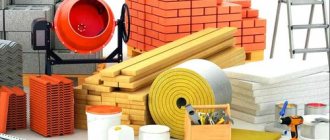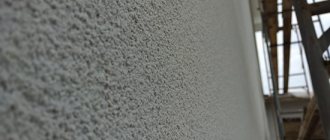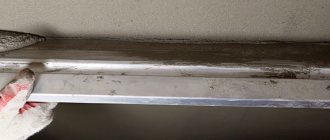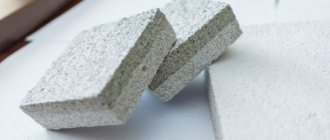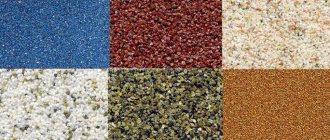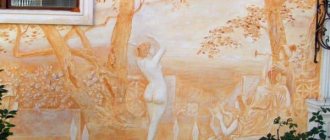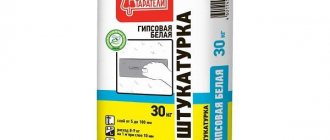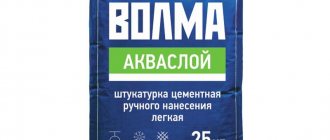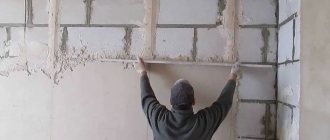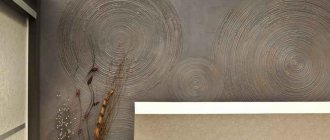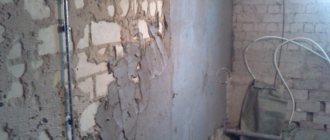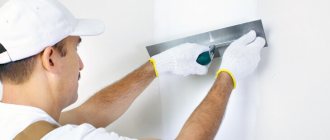A completed building cannot be considered ready until finishing work has been completed.
To level the surfaces of walls and ceilings, plasters are used based on water- or air-hardening binders (or a combination of both) - cement, lime, gypsum.
Important!
Plasters, in addition to the main one - leveling surfaces - also perform other functions: preparing surfaces for applying decorative coatings (for example, painting, laying tiles, wallpapering), increasing sound and heat insulation. Plasters can also have special properties, for example, antibacterial. There are decorative plasters that themselves act as a finishing decorative coating, but more on that later.
The main difference between plasters and putties is the thickness of the coating. For plasters it is 5–80 mm, while putties are applied in a layer of up to 5 mm.
Concept and features.
Plaster is a hardened layer of mortar that is used for finishing residential and commercial premises. Conventional solutions are used to prepare surfaces for decoration, as well as to protect the facade from unfavorable environmental conditions that are destructive. Special solutions are used when it is necessary to create the following coatings:
- Shielding membranes.
- Partitions.
- Isolation of surfaces from penetration of various types of radiation.
Solutions for decorative purposes are used when finishing structures in order to increase their aesthetic appeal.
Plaster is used during construction work to level the surfaces of the room, as well as for decorative purposes. It can create an imitation of brickwork. Often, when using piece materials for construction, joints are formed, which can best be hidden by the cement type of plaster.
Solutions of various colors are used to add coziness to rooms. Decorative cement plaster is intended not only to mask uneven walls or ceilings, it also has good sound insulation properties and helps retain heat in the room.
It is often used to provide fire resistance to the walls of industrial and residential buildings.
Where is white cement used?
White cement is widely used. It is found in almost every building, and sometimes its use becomes the only solution. Areas of application:
- A variety of building elements are made from it. White cement is often used for finishing facades. It makes the structures under construction more durable and expressive;
- Thanks to its good technical characteristics, the material is in demand for work both outside and inside buildings. The fact is that the color of white concrete does not change after years of use, despite the aggressive effects of various atmospheric phenomena;
- white cement is popular among architects and manufacturers of cement products, as it makes it possible to turn interesting ideas into reality. So, shapes, fillers, and colors change. The hardened surface is also treated in different ways;
- it is used to produce ready-made plaster, mortars, dry mixtures and materials for filling joints;
- develop elements of park and garden furniture, artistic products;
- White cement is used to make flooring materials, for example, colored paving slabs;
- applicable if it is necessary to restore a historical relic.
Important! The wide range of applications is explained both by the technical characteristics of the material and by its visual appeal - whiteness. To maintain the whitish tint, no additional protective measures are required.
What to choose for finishing?
In order to finally understand which plaster is better, gypsum or cement, you need to understand their key differences and the features of each of them. For example, today there are many options and modifications of plaster solutions, depending on the ingredient that forms its basis.
Thus, a cement mixture for plastering walls assumes the presence of cement, but it can be replaced completely or in certain quantities by other substances:
- lime;
- clay;
- gypsum.
There are a large number of possible options, but the most popular are usually plaster mixtures containing cement or gypsum for finishing walls and other surfaces.
This material is characterized by first-class strength and durability. The proportions of the components of cement plaster may differ, depending on the base substance included in its composition. So, in addition to the constant components that, one way or another, are used in each solution (cement, water), cement plaster for interior work, as well as that used for exterior decoration, can be based on sand or lime.
The resulting sand-based building material is usually made using proportions of four parts cement to one part sand, with water added to bring the mortar to a workable consistency. A similar mixture is used to seal cracks and depressions in the walls of the interior of buildings, and also as facade cement plaster to form smooth surfaces with regular angles.
What are the types of plaster mortars based on the type of binder?
There are three types of binders on the basis of which plaster mortars are made:
- cement;
- lime;
- gypsum.
Accordingly, plaster mortars can be cement-sand, gypsum, lime, as well as mixed types: lime-gypsum, cement-lime, cement-clay. They exploit the strengths of different types of binders.
Important!
Cement plasters, unlike lime and gypsum plasters, are suitable for wet rooms and for outdoor use.
The following types of plasters are prepared based on cement:
- cement-sand;
- cement-lime;
- cement-clay.
Hidden and obvious benefits.
To compensate for the main disadvantage of sand mixtures - their significant weight, slaked lime is added as the main component. The composition of facade cement plaster with the addition of lime also includes Portland cement, additives with water-retaining properties, quartz sand of various fractions and others.
Such cement plaster provides the necessary microclimate and humidity level for the structures being built, and is also characterized by good ability for high-quality adhesion to the surface on which it is applied.
The benefits that this mixture has are quite extensive. Firstly, it is very durable, which makes it possible to carry out repairs after its use much less frequently. Secondly, a high degree of adhesion - adhesion to the surface, ensures long-term preservation and no need to add accompanying additives to increase its strength. Cement plaster, the preparation proportions of which do not require expensive or rare materials, is affordable.
Gypsum plaster is convenient for use on surfaces that do not tolerate the cement type. These can be painted walls or areas of surfaces made of plastic or wood. It also does not require such a professional and multi-stage approach during application as cement.
Thus, this material is better suited for finishing facades, wet and damp rooms that are exposed to humidity. Gypsum can help in finishing surfaces on which cement simply does not adhere. This advantage is used when working with wooden, polymer, clay or ceramic surfaces.
Stages of work
To level the walls, galvanized lighthouse slats . Longitudinal beacons are installed along the floor plane to perform screeding.
A spatula is not used for laying; a trowel . They apply the solution to the wall. In another case, a plaster ladle , with which the mortar is thrown onto the wall in a “pull-away” motion.
Valera
The voice of the construction guru
Ask a Question
Beacons help to make a perfectly flat wall plane; sometimes it is impossible to achieve such a result without slats. If the application thickness is large, several layers are applied; repeated application is possible 3–4 days after the first layer. For greater thickness, a chain-link mesh must be installed.
Surface preparation
Before installing the beacons analyze the condition of the surface , study the verticality of the wall and evenness in the plane using a level, rule, and plumb line. Sometimes it helps to avoid thick layers by cutting off the protruding parts to make a rough alignment.
Pay attention to the condition of metal parts , traces of rust, moisture. They check the strength of the masonry , the presence of cracks, and take into account the distortions of structural lintels and beams.
Priming the wall
Preparatory work:
- removal of old layers, weak coating;
- jointing and filling cracks with mortar;
- coating of metal embedded parts and protruding reinforcement with an anti-corrosion compound;
- degreasing walls with solvents;
- antiseptic treatment;
- primer with deeply penetrating compounds.
are made on the concrete surface for better adhesion to the surface. The seams of brick and stone masonry are deepened by 0.5 - 0.7 cm.
For lime mortars on concrete, soil is used , which contains abrasive particles; it is not used for cement-sand mortars. In other cases, a penetrating solution will do.
The soil cannot be replaced by spraying with water. The liquid reduces the moisture-absorbing properties of the base only at first, and a protective film does not appear.
Plastering process
Beacons are installed at a distance of 20 cm from the corner, then mounted at a certain pitch. They are placed vertically, using a level.
At the same time, the slats are placed on the protruding edges of the slopes of doors and windows in the same plane as the wall (choose perforated slats, bent along the length at 90°).
The application technology includes three stages:
- Spraying the surface. The first layer is applied with a thickness of 5 - 10 mm, depending on the presence of reinforcing mesh. The consistency is reminiscent of thin sour cream.
- Base layer. Plaster dough of normal thickness is applied or poured using a trowel or ladle. Two or three leveling steps are allowed until an ideal surface is obtained. The excess is collected using a rule, placed in a bucket, and kneaded again.
- Covering . The final layer is made with a liquid solution, its thickness is 2 – 4 mm. Use a grater and spread it on the mixture.
Subsequent layers are laid after the previous ones have dried.
The hardened plaster is smoothed using a grater, pressing the tool tightly to the surface and making circular movements. A liquid solution is used to fill the depressions, and the protrusions are cut off with the edges of a grater.
Recommendations from experts
The lighthouses are galvanized, but the film is damaged and the metal rusts. Brown marks appear not only on plaster, they appear on the final finish (wallpaper, painting). Therefore, slats cannot be left in the wall.
Other tips:
- Before plastering a new building, the structure must undergo settlement so that the finishing coatings do not crack during the process.
- If the walls are smooth , beacons do not need to be installed, but levelness is checked using a rule with a built-in level.
Valera
The voice of the construction guru
Ask a Question
The solution is poured from the bottom up, starting from the floor, gradually rising. For a thick solution, it is better to use smooth slaps when pouring. Liquid mixtures are thrown with a sharp movement.
How to prepare cement plaster for interior work with your own hands.
When preparing a solution, it is important to understand that it traditionally consists of three elements:
- The first of which is necessary to bind the others (this is often cement, lime or clay).
- The second component acts as a filler and gives the main weight to the material (usually sand).
- The third element is water.
It is undesirable to violate the proportion when preparing the solution yourself. The optimal solution is to combine binders and filler components in equal parts.
Otherwise, if you overdo it with cement, many cracks will appear after hardening, and if you add too much sand, the solution will be brittle and crumbling. The most popular proportion when making mortar is the combination of sand and cement in the ratio: one part to three.
The fat content of lime is taken into account when making lime mortars. To increase its strength, add a kilogram of cement for every ten kilograms of solution. You can use a shovel or other auxiliary tools to mix it, but a construction mixer will do the job best.
Features of the technology.
In order to carry out plastering work yourself, you need to stock up on the following tools:
- Device for throwing on a wall.
- Leveling tool.
- Spatula for grinding the solution.
Before applying the prepared mixture, it is advisable to prime the surface to be treated or simply moisten it with water so that the liquid from the solution does not penetrate into the porous structure of the surface. When the stretched and leveled layer applied with a trowel dries, it’s time to grout.
To do this, using a polisher, apply a solution of a thinner consistency to the surface to be treated for final leveling.
The layer of plaster can be strengthened with reinforcement using a special mesh. Also, the dried layer can be etched with special preparations to prevent the development of fungi in it. When performing all this work, you must not forget about safety rules. To do this, you need to protect your hands with gloves, use a respirator or mask, a work gown, and work in a ventilated room.
The dried solution acquires final hardness approximately a month after application. Cracks may appear due to artificial acceleration of drying using blowing machines.
Can gypsum plaster be used for exterior use?
The gypsum-based mixture is characterized by a high water absorption coefficient. As a result, the plastered surface will be hygroscopic. Thanks to the polymer and mineral substances used in production, it is possible to increase the moisture resistance and frost resistance of gypsum plaster. However, this is not enough for using the product on facade work. You can’t do without persistent hydrophobic compounds.
It is allowed to use gypsum plaster for external work only if it is applied in an intermediate layer, which is covered with a moisture-resistant cladding on top. The finishing material must have good vapor permeability to avoid wetting the plaster ball.
On the market you can find gypsum plaster containing GPCV (gypsum-cement-pozzolanic binder) or gypsum polymer. This composition is able to withstand adverse environmental influences.
But manufacturers are hesitant to indicate outdoor use in the composition’s purpose due to uncertainty about its durability. You can try using it for a facade only if you live in a region with a dry, warm climate.
How to make functional and aesthetic repairs.
Decorative plaster is often used to give rooms and building facades additional aesthetic appeal. This technology is relatively cheap and can be applied in practice with one’s own hands.
It will not be news that decorative processing is carried out on leveled surfaces. On the facades of houses this most often happens after insulation work has been carried out. Traditionally, before applying the mortar, the surface of the building is primed, which ensures a better connection of the plaster with the base. It is also appropriate to use the primer for objects whose finishing is not completed before the onset of frost, for better preservation.
With this type of wall treatment, ready-made plaster or dry mixtures are used. It is applied with a spatula and then rubbed. The rubbing technique plays a special role, since it is this that gives a unique pattern to the finishing of the structure. If you add special small balls to the mixture, the plaster will come out with grooves and depressions, which will give it a special flavor.
When performing work, it is important not to stop until the finishing of the full area of one of the surfaces is completely completed, since if you do the opposite and continue work after part of the wall has already dried, noticeable stains and tonal transitions may appear between the treated areas. It is better not to work in hot weather, since rapid drying will not benefit the quality of the plaster. After the solution has completely dried, the surface is primed again.
Blowing hot air onto the walls can significantly damage the applied layer. With partial drying or uneven distribution of air streams, the material may sag, crack and deform, which, of course, is quite undesirable.
It is better to speed up the hardening process not with the help of heat treatment, but with the addition of plasticizers, which will reduce drying down to several days, without disturbing the structure of the solution and without causing the appearance of cracks and bubbles.
Advantages and disadvantages
Figure 2. Application of white cement
Compared to gray varieties, white cement has a lot of positive properties that only expand its scope of application:
- hardens quickly. 16 hours after pouring, the material gains 60% strength. Gray cement requires a minimum of 3 to 4 weeks. Thanks to the rapid hardening of concrete, builders gain a lot of time;
- high dispersion index, protecting products from negative atmospheric influences. The color of the cement will remain the same, even if the material is exposed to snow, rain, or sunlight for a long time. Natural factors of destruction also appear much later than in classical concrete;
- Compared to gray cement, white has twice the resistance to cracking. The fact is that the material is made from high-quality clinker with less added impurities;
- environmentally friendly. The raw materials for production are those that occur naturally;
- attractive appearance. White surfaces are easier to combine with finishing, and they look brighter than being gray.
If you add natural pigments to the mix, you can paint the product a different color. Options for additives and what color they give: red lead, ocher – yellow, cobalt – blue, manganese carbonate – black.
One of the significant disadvantages of white cement, which is also called decorative, is its high price (almost 25% more expensive than gray cement). Also, mixtures, both ready-made and dry, need protection from foreign inclusions. That is, you cannot prepare cement using dirty tools with rust. Reinforcement work also becomes more complicated - the rods must be protected from rust.
Due to the high cost and complexity of work, in Russia 1-2 bags of white are required per 100 bags of gray cement. However, construction and finishing technologies do not stand still, and they are pushing the industry towards new trends and solutions.
Figure 2. White cement buildings
We buy ready-made ones.
Knauf cement plaster is universal in color range. So, in particular, you can buy both white cement plaster and materials of intermediate shades, up to gray. Such differences in color are explained depending on the content of inorganic elements or compounds in the gypsum stone.
Knauf is ideal for treating concrete surfaces and eliminates the need for puttying. Knauf is represented by brands of more than ten names, which allows you to choose the one that will ideally fulfill the task assigned to it.
One of the types of Knauf plasters is Rotband cement plaster, which has a number of advantages over others. So, in particular, its consumption when processing surfaces is half as much as other similar options. In addition, it is safe and does not interfere with the penetration of steam, and also does not deform when applied in a thick layer. Rotband has found application in restoration work, as well as as decorative cement plaster.
Cement plaster KREPS is used when processing uneven surfaces. It can be cement and gypsum and is used when it is necessary to create a high-quality coating of surfaces with varying degrees of adhesion. It can be applied either manually or using special automatic mechanisms.
Some types of this plaster can be supplemented with modified additives of minerals and polymers to increase its plasticity. Kreps, as a facade cement plaster, has a fine-grained base and, after hardening, is highly resistant to frost.
Criterias of choice
Selection of plaster
On what basis?
The purpose is determined by the components of the composition.
Plaster
The main component is gypsum. In addition to it, various mineral additives are used to give the solution certain qualities. This species is characterized by low resistance to moisture and limited viability time. The treated surface is weakly resistant to mechanical stress. This narrows the scope of application of plaster, in contrast to cement and lime composition.
Among the advantages of the gypsum mixture: rapid hardening, no need for additional surface treatment, simple method of application. When working with the solution, common problems such as layer slipping are not observed. Characterized by high plasticity. It lays flat on the surface and does not shrink after hardening.
Cement
This is the most popular composition. The main function is performed by cement. Sand and other fillers give the solution elasticity and strength. This type is suitable for interior and exterior work.
Among the advantages: resistance to atmospheric factors and aggressive environments, durability. The plaster is easy to use and remains viable for a long time. The low cost of the material is considered a pleasant bonus.
When choosing a cement composition, it is important to take into account its disadvantages. It takes a long time to dry, which delays further installation. Putty must be applied over the plaster to smooth the surface. The solution distribution technique deserves special attention. Sometimes it’s impossible for a beginner to cope.
Limestone
The composition is based on lime and sand. Cement and other fillers can also be used to impart certain properties to the solution. Most often, lime plaster is used for interior work. But it is also used for the facade.
This type is characterized by relatively fast hardening and antibacterial properties. Other advantages include excellent adhesion, prevention of fungus and mold. The pricing policy is affordable.
When using the material, the following disadvantages should be taken into account: insufficient strength, low resistance to a humid environment.
Lime-cement plaster KREPS Extra-light, 25 kg
Cement-lime
This type is used for interior work in rooms with high humidity levels. The solution becomes less durable as the proportion of lime in the total volume of the composition increases. In addition, the hardening time of the plaster increases.
The cement-lime mixture is not recommended for application to painted surfaces, wooden parts, and plastic.
Mineral heat-resistant plaster TERRACOTTE 10 kg
Mineral
The composition includes small fragments of marble chips, granite, and lime. Light cement is also added. This combination gives the solution high decorative qualities. Mineral plaster adheres to the base more tightly than other types. It takes 1-2 days to dry, although already 20 minutes after application the mass hardens.
You should work quickly with the mineral mixture due to the short pot life of the solution. Apply it, forming an even layer without corrections.
Advantages: high resistance to microbiological processes, vapor permeability, heat and sound insulation qualities.
Polymer
When producing a dry mixture, resin copolymers (silicone, acrylic, siloxane), liquid potassium glass and other components are used to give the plaster elasticity and resistance to aggressive environments.
The polymer composition is used to treat surfaces and is used as the basis for decorative plaster, which includes crushed rock (granite, quartz, marble, etc. minerals). The product is distinguished by its high strength, good adhesion, and a wide selection of colors.
Polymer plaster is produced with different bases depending on the components of the composition (acrylic, silicone, silicate).
Silicate
Used mainly for outdoor work. The composition is characterized by high adhesion and hydrophobicity. It is convenient to work with the solution due to its elasticity. The surfaces are breathable, which is ensured by vapor permeability.
Advantages: no cracks after drying, uniform structure.
Plaster also has disadvantages: limited color options; before applying the solution, the surface must be treated with a special silicone-based primer; the cost cannot be called affordable.
Popular brands
In order not to be mistaken with quality, it is recommended to give preference to well-known brands. Large companies constantly improve their products, strictly adhere to the technological process, and use only certified raw materials. Among the popular brands: KNAUF, Perel, Ceresit, GLIMS, Unis, Kreps, Volma, Caparol, etc.
Grain size, mm
To produce each type of plaster mixture, certain raw materials with different particle fractions are used. The average grain size is 0.5-4.0 mm. In the mineral composition, large filler parameters are used (4.0-6.0 mm).
Minimum and maximum layer thickness, mm
The thickness of the plaster ball is determined by the grain fraction and the type of base. The functionality of the plaster is also taken into account.
Experts recommend not applying a solution less than 0.5 mm thick. A thin ball will not be strong enough. Due to minor mechanical loads, cracks and peeling occur.
The maximum value cannot exceed 2-2.5 cm (per application). If the thickness is insufficient, you can apply a second ball, but only after the previous layer has completely dried.
A popular type of cement-based plaster is applied in a layer of 5 to 40 mm. Using a gypsum composition, it is possible to form a ball up to 100 mm.
Application
Mixtures are produced for facades and interior works. Their compositions differ. Manufacturers indicate on the packaging the conditions for which the plaster is intended.
- For outdoor use, they are characterized by durability, strength and resistance to various influences (atmospheric, mechanical). The treated surface can withstand sudden temperature changes, frost, and ultraviolet radiation.
- The product for indoor use is environmentally friendly and has decorative qualities.
Regardless of the purpose, you need to choose the composition taking into account the type of base (wood, brick, concrete, etc.). The division based on the scope of application is a convention. In most cases, they are used for facades and indoors.
Where is the best place to order and buy.
The price of plaster depends on the “promotion” of the brand under which it is produced, as well as on the cost of its components. If you can’t prepare it yourself, you can buy it ready-made in building materials stores. To do this, it is not necessary to directly visit such stores; it is enough to place an order on one of the Internet sites that represent real-life retail outlets.
You can also purchase a wholesale batch by placing a preliminary order on one of the electronic trading platforms.
In order not to be mistaken with the type of plaster that is required for finishing work, you should calculate how much of it is per m2, as well as how much you will have to pay per square meter. Material consumption per sq. m. must be multiplied by the area of the planned work to clarify their book value. data-matched-content-ui-type=”image_stacked” data-matched-content-rows-num=”2″ data-matched-content-columns-num=”3″ data-ad-format=”autorelaxed”>
White cement brands
The grade designated by the letter “M” characterizes the strength of cement. The following brands are available:
- M400 - of all possible ones, it has the lowest strength, shrinks and has low sulfate resistance;
- M500 – durable and frost-resistant mortar with low deformation;
- white cement class M600 is frost-resistant, hardens quickly and practically does not “shrink”;
- M700 is a modern and innovative variety, a kind of European standard.
In finishing and construction work, the most popular grades are M500 and 600.
